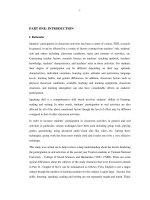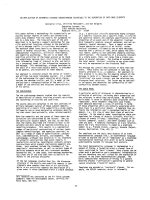E00 10 simple photography techniques to get an artistic picture
Bạn đang xem bản rút gọn của tài liệu. Xem và tải ngay bản đầy đủ của tài liệu tại đây (1008.58 KB, 9 trang )
10 basic photography knowledge for beginners
You're new to photography and you want to capture beautiful pictures?
You want to learn more about photography without knowing where to start?
You want to participate in photography classes but there' s not much time and
conditions?
You're confused about the meaning of terms like "shutter speed”, "aperture",
“Sensitivity iso", "exposure compensation”, "white balance" …
Not to worry - the series of basic pixels about camera will take you through the key
concepts of photography, so that you will not only understand more about the camera,
but also better understanding how you can refine the regimes and set up the camera!
1. Learn about lens aperture
Aperture is the aperture of the lens denoted by F/X (where X is the aperture of
the lens indicated by a specific number, for example F/2; F/1.8; F/4…. The
smaller the X value, the larger the aperture, for example, F/2 will be larger than
F/4; F here is 1F. In simpler words, 1F/2=0.5 will be larger than 1F/4=0.25.
The larger the aperture, the more light enters the sensor, helping to reduce noise
and vibration, blur when low light leads to a reduced shutter speed, but it is not
always advisable to open the maximum aperture because there are some
Lenses are out of focus at maximum aperture so you should reduce a few stops
for example from F/1.8 to F/2.8….
To learn more about aperture, please read the document “01_Aperture”
I attached
2. Camera shutter speed
This is the shutter speed of the camera on a photograph, the shutter speed,
whether a photo has good sharpness or not, this factor will also be a deciding
factor.
For example, when photographing an event, you are capturing the subject of
event participants who are constantly moving. If the speed you set is lower than
1/100 of a second, there are long trails for motion that the camera has not fully
captured, the shutter speed is too low, if you increase the shutter speed from
1/100 to 1/400, you You will see the difference when capturing motion.
For a more in-depth look at aperture, please read the enclosed
“02_SHEET SPEED” document.
3. ISO - the camera's light sensitivity
This is one of the three important elements in photography. Usually the lowest
ISO in current models is from 50-200 and the highest can be up to 256,000. If the
lighting conditions are good, you can set the ISO to the lowest. On the contrary,
when entering low-light places, you must increase the ISO to compensate for
exposure, and therefore the higher the ISO, the more noise will be.
To learn more about aperture, please read the attached “03_SENTENCE”
document
4. White balance WB
It can be easily said that this is the color temperature of the image, sometimes
you will see that the image will be blue or yellow… Mostly because the machine
perceives the light incorrectly or is affected by the color lights of the outside.
school.
In terms of color temperature, it is expressed in K (kelvin) temperature and
ranges from 1000->10,000. At a temperature of 1000, it will have a red-orange
color and the more it increases, it slowly turns yellow, then green, then blue…
Specifically, please see the illustration below for easy understanding.
To learn more about aperture, please read my attached “04_BALANCER”
document
5. Exposure
Actually exposure is related to shutter speed, which is the amount of time it takes
for the amount of light to enter the sensor. The average exposure time I often use
is from 1 second to 30 seconds, many people will long exposure with Built mode
by using a remote or soft button to expose as long as they like for longer than 30
seconds. Too much exposure will affect the sensor, so please consider it.
To learn more about aperture, please read the attached “05_EXPOSURE”
brochure
6. Lens focal length
Lenses include super wide-angle lenses smaller than 21mm including an 8mm
fisheye lens, these lenses take architectural or historical photos with strange
effects. Next is the wide-angle focal length from 21-35mm used for landscape
photography. The standard focal length is 35-70mm used for daily life, reportage,
portraits. Next is the average telephoto focal length from 70-135mm used for
product photography, portraits. And a super telephoto lens with a focal length
greater than 135mm…
To learn more about aperture, please read my attached “06_Camera focal
length” document
7. Depth of field
Depth of field can be said to be the font removal of the lens, the more the
background is removed, the thinner the DOF. For example, a long telephoto lens
will have a thinner DOF than a short wide lens. The thinner the depth of field, the
stronger the background removal image, the more shimmering the image will be.
However, the disadvantage is that the image is easily out of focus because the
DOF is too thin. So when shooting, you prioritize the high shutter speed and can
increase the ISO if possible. When shooting landscapes, you should narrow the
aperture down to F/8 or smaller for even and good sharpness.
8. Metering Mode
The machine supports different metering modes, depending on what you are shooting
for to give appropriate metering patterns. For portraiture, you can use Spot metering to
measure the exposure of the sample, and for landscape photography, you can meter
the entire image to get the right brightness…. When the metering is successful, you can
hold the light lock button to conveniently compose the photo…
9. Focus modes on photos
In the camera, there are many different focus modes, depending on the subject
and the number of people shooting, you choose the appropriate focus mode.
For example, when taking a lookbook, you should choose the point-based focus
mode and focus on the eye of the model. And when shooting with a large number
of people, you should prioritize using 3D focus mode or use the mode to make
full use of the machine's focus points and besides, will close the aperture down to
make the depth of field thicker and more evenly focused. . For landscape
photography, you also choose the mode that prioritizes all the focus points the
camera supports.
For a more in-depth look at aperture, please read the “09_FOCUS” document I
attached
10. DSLR Camera Modes
There are 3 modes that are most used for DSLR cameras. That is M (Full
manual) for interior and architectural photography, A (aperture priority) mode for
events, weddings, parties... and Auto (full auto). when you lend your camera to
someone you know and take pictures of the landscape.
To learn more about aperture, please read the “10_PROGRAM” document I
attached.









